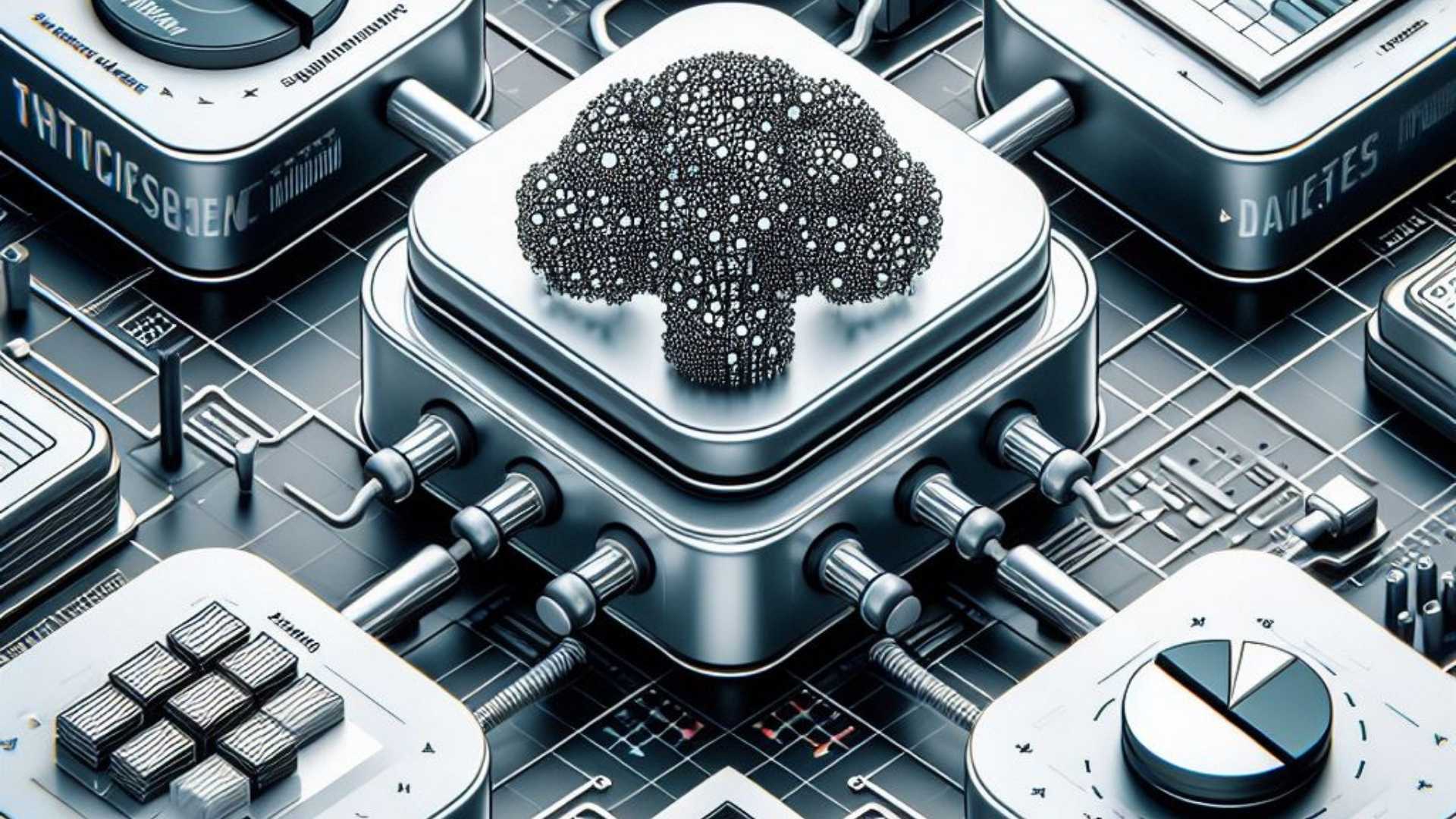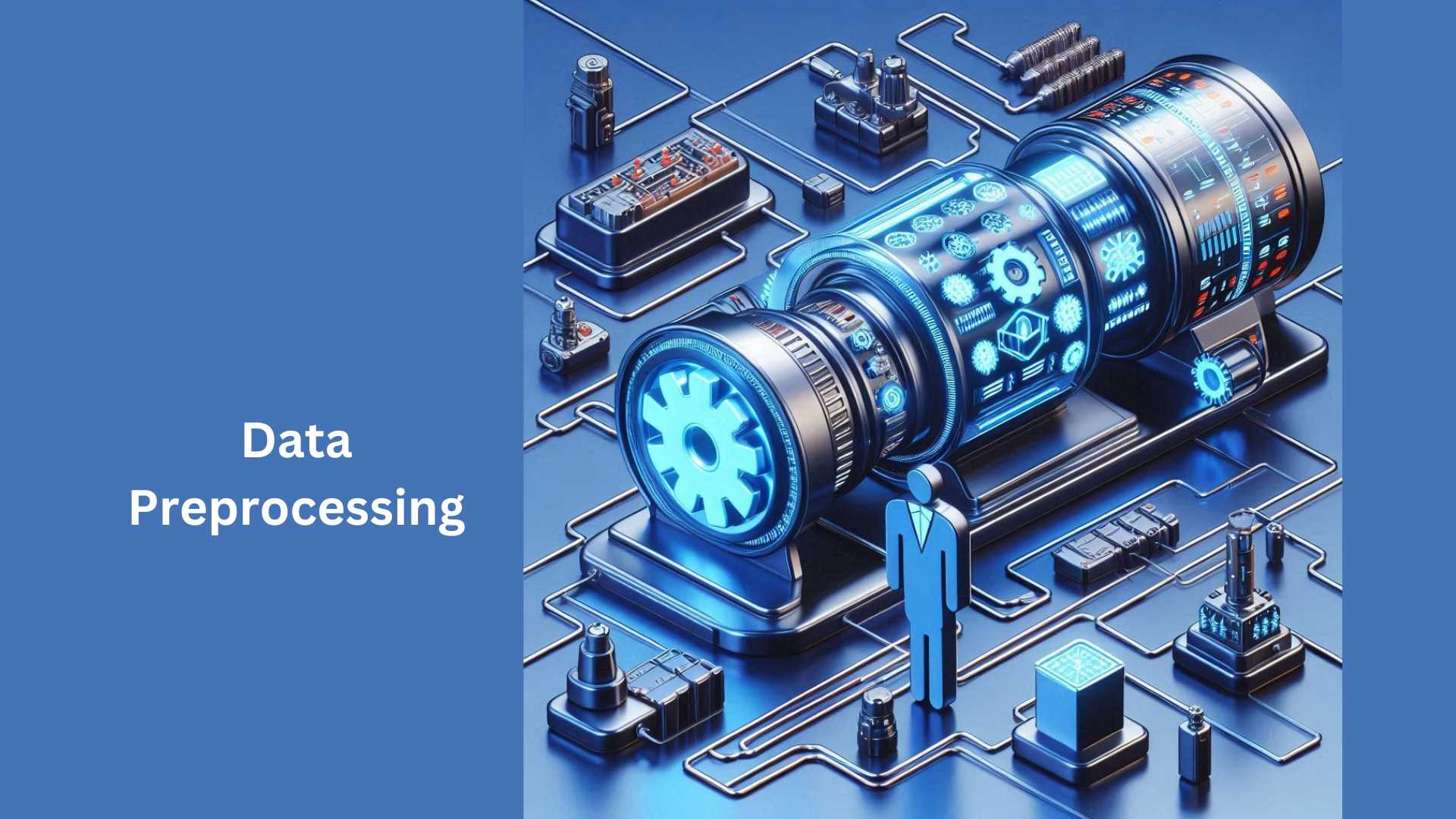AI Potential is an initiative focused on exploring the capabilities of Artificial Intelligence (AI), abbreviated as AI. It’s a field within computer science dedicated to developing machines that mimic human-like behaviors. These intelligent systems are engineered to undertake activities traditionally necessitating human intelligence, like learning, problem-solving, comprehending natural language, and identifying patterns. AI frameworks rely on algorithms and data to empower them to make decisions, adjust to novel circumstances, and enhance their efficiency progressively.
Artificial Intelligence: For Tomorrow’s Intelligent Systems
AI can be defined as the simulation of human intelligence processes by machines, especially computer systems. It encompasses various subfields, including machine learning, natural language processing, computer vision, robotics, and expert systems. AI systems can analyze large amounts of data, extract meaningful insights, and make predictions or decisions based on the available information. The ultimate goal of AI is to create machines that can perform tasks autonomously, with a level of intelligence comparable to or exceeding that of humans.
Brief History of Artificial Intelligence Development
The development of AI can be traced back to the mid-20th century, although the concept of artificial beings with human-like intelligence dates back to ancient times. Here’s a brief overview of key milestones in Artificial Intelligence development:
| Year | Advancement in AI Development |
| 1943 | McCulloch and Pitts propose the first mathematical model of a neural network. |
| 1950 | Alan Turing publishes “Computing Machinery and Intelligence”, proposing the Turing Test. |
| 1956 | Dartmouth Conference marks the birth of AI as a field. |
| 1957 | Perceptron, the first artificial neural network, is created by Frank Rosenblatt. |
| 1969 | The first expert system, Dendral, is developed for chemical analysis. |
| 1974 | The first AI winter begins, characterized by reduced funding and interest in AI research. |
| 1980s | Expert systems become popular in various industries. |
| 1986 | Geoffrey Hinton, David Rumelhart, and Ronald Williams published the backpropagation algorithm. |
| 1997 | IBM’s Deep Blue defeats Garry Kasparov in a game of chess. |
| 2000s | Rise of machine learning and data-driven approaches in AI. |
| 2010s | Deep learning gains prominence, leading to breakthroughs in speech recognition, image recognition, and natural language processing. |
| 2012 | AlexNet wins the ImageNet competition, sparking the deep learning revolution. |
| 2016 | AlphaGo defeats Lee Sedol, a world-champion Go player. |
| 2017 | AlphaGo Zero, trained solely through reinforcement learning, surpasses the abilities of AlphaGo. |
| 2019 | GPT-2, a large-scale language model, is introduced by OpenAI. |
| 2020s | Continued advancements in AI applications across various domains, including healthcare, finance, and transportation. |
| 2021 | OpenAI releases GPT-3, the largest and most powerful language model at the time. |
| 2024 | Ongoing research focuses on addressing ethical, societal, and safety concerns in AI deployment. |
The field of AI has undergone significant evolution since its inception, with advances driven by interdisciplinary collaboration, technological innovation, and evolving societal needs. As AI continues to progress, its impact on various aspects of human life is expected to grow, presenting both opportunities and challenges for society.
Understanding AI’s Potential
Artificial Intelligence (AI) has emerged as a transformative technology with vast potential to revolutionize numerous aspects of human life. By mimicking human intelligence processes, AI systems can analyze vast amounts of data, identify patterns, and make predictions or decisions with remarkable accuracy. Understanding AI’s potential requires exploring its advancements and applications across various industries.
Advancements in Artificial Intelligence Technology
The field of AI has witnessed rapid advancements in recent years, fueled by breakthroughs in machine learning, neural networks, natural language processing, and computer vision. These advancements have enabled Artificial Intelligence systems to achieve unprecedented levels of performance in tasks such as image recognition, speech synthesis, language translation, and autonomous decision-making. Key developments include deep learning algorithms, reinforcement learning techniques, and the proliferation of AI frameworks and tools like TensorFlow and PyTorch.
Applications across Various Industries
AI technologies have found applications across diverse industries, transforming traditional processes and driving innovation. Some notable sectors leveraging AI include:
- Healthcare: AI is revolutionizing healthcare by enhancing diagnostics, personalizing treatment plans, and streamlining administrative tasks.
- Machine learning algorithms analyze medical images to detect diseases, while predictive analytics models forecast patient outcomes and recommend interventions.
- Virtual health assistants and chatbots provide personalized healthcare advice and support, improving patient engagement and access to care.
- Finance: In finance, Artificial Intelligence algorithms power risk assessment, fraud detection, algorithmic trading, and customer service automation.
- Natural language processing (NLP) enables sentiment analysis of financial news and social media to inform investment decisions.
- AI-driven chatbots assist customers with queries and transactions, reducing operational costs and improving service efficiency.
- Education: AI is reshaping education through personalized learning experiences, adaptive assessments, and intelligent tutoring systems.
- Machine learning algorithms analyze student performance data to tailor educational content and recommendations to individual needs and learning styles.
- Virtual tutors provide real-time feedback and assistance, fostering student engagement and mastery of complex concepts.
- Manufacturing: AI is driving the transition to smart manufacturing by optimizing production processes, predictive maintenance, and quality control.
- Robotics and automation systems powered by AI enhance efficiency and flexibility in manufacturing operations.
- Predictive analytics models anticipate equipment failures and schedule maintenance proactively, minimizing downtime and maximizing productivity.
- Transportation: In transportation, AI enables autonomous vehicles, route optimization, and predictive maintenance for fleets.
- Self-driving cars equipped with AI perception and decision-making capabilities promise safer and more efficient transportation systems.
- AI-powered algorithms analyze traffic patterns and historical data to optimize routes and reduce congestion, enhancing overall mobility and sustainability.
Each industry’s adoption of Artificial Intelligence presents unique opportunities and challenges, with the potential to reshape business models, improve operational efficiency, and enhance customer experiences. As AI continues to evolve, its impact across diverse sectors will only grow, unlocking new possibilities for innovation and growth.
The Crucial Importance of Artificial Intelligence Potential
Artificial Intelligence (AI) is increasingly becoming a cornerstone of modern economies and societies. Recognizing its potential is crucial for several reasons:
- Economic Growth and Competitiveness: AI has the potential to revolutionize industries, enhance productivity, and drive economic growth. Businesses that harness AI technologies can gain a competitive edge by automating tasks, optimizing processes, and making data-driven decisions. Recognizing AI’s potential enables countries to invest in research, education, and infrastructure to foster innovation and maintain competitiveness in the global market.
- Job Creation and Transformation: While AI has the capability to automate routine tasks, it also creates opportunities for new jobs and career paths. Recognizing AI’s potential allows policymakers, educators, and businesses to prepare for the workforce’s changing demands. By investing in reskilling and upskilling programs, individuals can adapt to the evolving job market and thrive in AI-driven industries.
- Improved Public Services: AI applications have the potential to enhance public services, including healthcare, transportation, and urban planning. Recognizing AI’s potential enables governments to leverage data analytics, predictive modeling, and automation to deliver more efficient and responsive services to citizens. From personalized healthcare treatments to optimized traffic management systems, AI can improve the quality of life for people around the world.
- Innovation and Discovery: AI accelerates scientific research and discovery by analyzing vast amounts of data, identifying patterns, and generating insights. Recognizing AI’s potential fosters collaboration between researchers, engineers, and domain experts to tackle complex challenges in fields such as medicine, climate science, and space exploration. By leveraging Artificial Intelligence technologies, once unimaginable breakthroughs become achievable, leading to advancements that benefit society as a whole.

Impact on the Economy and Society
The impact of AI on the economy and society is profound and multifaceted:
- Labor Market Disruption: AI-driven automation has the potential to disrupt traditional labor markets by displacing certain jobs while creating new opportunities. Industries such as manufacturing, retail, and customer service are experiencing significant changes as AI technologies automate repetitive tasks and augment human capabilities. Recognizing the impact of AI on the labor market is essential for policymakers to implement strategies that support displaced workers, promote job transitions, and ensure inclusive economic growth.
- Income Inequality and Skills Gap: The adoption of AI technologies may exacerbate income inequality and widen the skills gap between highly skilled workers and those with lower levels of education or technical expertise. Recognizing the socio-economic implications of AI enables policymakers to implement policies that promote equitable access to education, training, and employment opportunities. By investing in lifelong learning initiatives and social safety nets, societies can mitigate the negative effects of AI-driven disruptions and foster inclusive prosperity.
- Ethical and Social Implications: AI raises ethical concerns regarding privacy, bias, transparency, and accountability. Recognizing the ethical implications of AI requires careful consideration of how these technologies are developed, deployed, and regulated. Societies must establish ethical frameworks, standards, and regulations to ensure that AI systems are designed and used in ways that respect fundamental human rights, promote fairness, and mitigate potential harms. By fostering ethical AI practices, societies can harness the benefits of AI while minimizing risks and safeguarding societal values.
- Cultural and Behavioral Shifts: AI’s pervasive influence on daily life, from personalized recommendations to autonomous decision-making systems, shapes cultural norms and behaviors. Recognizing the societal impact of AI entails understanding how these technologies influence human behavior, social interactions, and cultural practices. By promoting digital literacy, critical thinking, and responsible use of AI technologies, societies can empower individuals to navigate the complex socio-technical landscape and shape AI-driven futures that align with collective values and aspirations.
Ethical Considerations
Ethical considerations are paramount in the development, deployment, and use of AI technologies:
- Fairness and Bias: AI systems can perpetuate or exacerbate existing biases and inequalities if not designed and trained properly. Ethical considerations involve addressing biases in data, algorithms, and decision-making processes to ensure fairness and equity for all individuals and groups. By promoting diversity, inclusivity, and algorithmic transparency, developers and practitioners can mitigate bias and promote social justice in AI applications.
- Privacy and Data Protection: AI relies on vast amounts of data, raising concerns about privacy infringement and data misuse. Ethical considerations encompass respecting individuals’ privacy rights, obtaining informed consent, and implementing robust data protection measures. By adopting privacy-preserving technologies, anonymization techniques, and stringent security protocols, organizations can uphold individuals’ privacy while harnessing the power of data for AI-driven innovation.
- Transparency and Accountability: Ethical AI requires transparency in how AI systems are designed, trained, and deployed. Stakeholders should have a clear understanding of AI’s capabilities, limitations, and potential impacts to make informed decisions. Ethical considerations also entail establishing mechanisms for accountability and recourse in cases of AI errors, biases, or unintended consequences. By fostering transparency and accountability, developers, policymakers, and users can build trust in AI technologies and ensure responsible AI governance.
- Human-Centered Design and Control: Ethical AI prioritizes human values, autonomy, and well-being in the design and use of AI systems. Ethical considerations involve placing humans at the center of AI development, respecting their autonomy, and empowering them with control over AI-driven decisions. By adopting human-centered design principles, incorporating feedback from diverse stakeholders, and prioritizing user agency, developers can create AI systems that enhance human capabilities and enrich human experiences while minimizing risks and harms.
Recognizing the ethical dimensions of AI is essential for building trust, fostering responsible innovation, and safeguarding societal values in an increasingly AI-driven world. By integrating ethical considerations into every stage of the AI lifecycle, from design to deployment to decommissioning, we can harness the transformative potential of AI while ensuring that it serves the greater good and advances human flourishing.
Artificial Intelligence: Recognizing Its Challenges
- Fear of Job Loss: One of the most prevalent challenges in recognizing AI’s potential is the fear of job loss.
- Many individuals worry that as AI becomes more capable, it will automate tasks currently performed by humans, leading to unemployment and economic instability.
- This fear is particularly pronounced in industries where routine tasks are easily automated, such as manufacturing, transportation, and customer service.
- However, it’s essential to recognize that while AI may replace some jobs, it also creates new opportunities for employment in areas like AI development, data analysis, and human-AI collaboration.
- Ethical Concerns: Ethical concerns surrounding AI’s potential are another significant challenge.
- As AI systems become increasingly sophisticated, questions arise about how they should be programmed to behave ethically.
- Issues such as algorithmic bias, privacy violations, and the potential for autonomous AI to make morally consequential decisions raise complex ethical dilemmas.
- Policymakers, developers, and society at large must address these concerns to ensure that AI technologies are deployed responsibly and in alignment with ethical principles.
- Bias in AI Algorithms: Bias in AI algorithms presents a substantial obstacle to recognizing AI’s potential.
- AI systems learn from data, and if that data is biased, it can perpetuate and even exacerbate existing societal inequalities.
- For example, biased algorithms in hiring or lending processes can discriminate against certain demographics, perpetuating systemic biases.
- Addressing bias in AI algorithms requires careful attention to data collection, algorithm design, and ongoing monitoring to ensure fairness and equity in AI-driven decision-making.
- Regulatory Challenges: Regulatory challenges pose significant barriers to realizing AI’s potential.
- The rapid pace of AI development often outstrips the ability of regulatory frameworks to keep pace, leading to gaps in oversight and accountability.
- Additionally, differing regulatory approaches across jurisdictions can create uncertainty for companies developing and deploying AI technologies.
- Establishing clear, comprehensive regulations that balance innovation with safeguards for privacy, security, and fairness is essential to fostering trust and maximizing the benefits of AI.
- Misconceptions and Fear: Misconceptions and fear surrounding AI hinder efforts to recognize its potential fully.
- Portrayals of AI in popular media often sensationalize its capabilities, leading to exaggerated fears of AI-driven dystopias or widespread job displacement.
- Addressing these misconceptions requires education and public engagement to foster a more nuanced understanding of AI’s capabilities, limitations, and potential benefits.
- By demystifying AI and promoting informed discourse, society can better harness its potential for positive impact.
- Lack of Awareness: A lack of awareness about AI and its potential applications represents a significant challenge.
- Many individuals, businesses, and policymakers may not fully understand how AI works or the range of opportunities it presents.
- This lack of awareness can lead to missed opportunities for innovation and adoption of AI technologies.
- Efforts to increase awareness and literacy about AI, including education and training programs, knowledge-sharing initiatives, and public outreach campaigns, are essential to unlocking AI’s full potential and ensuring that its benefits are equitably distributed across society.
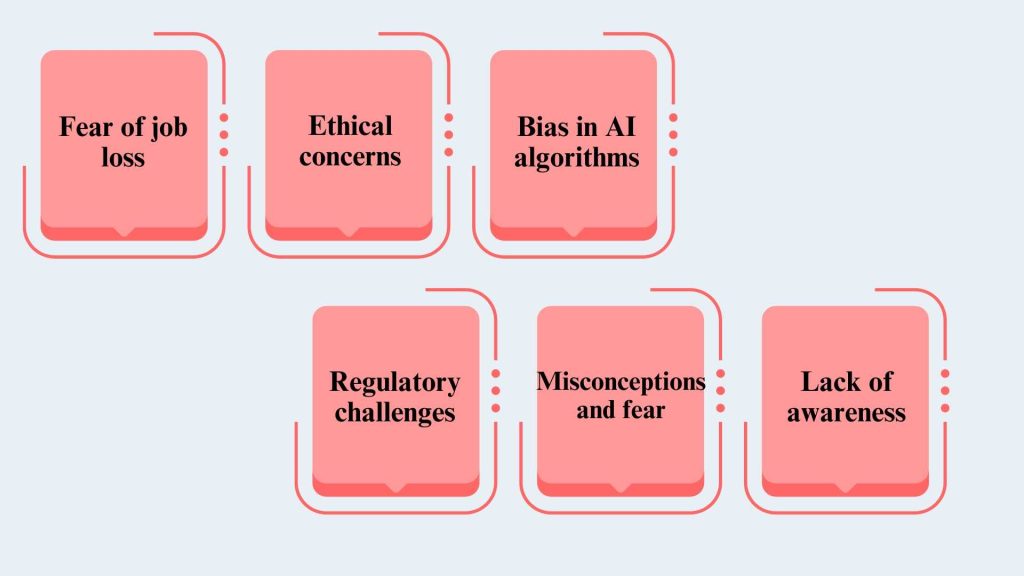
Benefits of Embracing AI
- Increased Efficiency: Embracing AI technologies can significantly enhance efficiency across various processes within an organization.
- Through automation of repetitive tasks, AI frees up human resources to focus on more complex and creative endeavors.
- For instance, in manufacturing, AI-powered robots can streamline production lines, leading to faster throughput and reduced error rates.
- In customer service, AI chatbots can handle routine inquiries, allowing human agents to tackle more challenging issues.
- Overall, the integration of AI boosts productivity and operational efficiency.
- Improved Decision-Making: AI empowers businesses to make data-driven decisions with greater accuracy and speed.
- By analyzing vast amounts of data in real time, AI algorithms can identify patterns, trends, and correlations that might elude human analysts.
- This enables organizations to anticipate market changes, optimize resource allocation, and mitigate risks more effectively.
- For example, in finance, AI-powered predictive analytics models can forecast market trends and guide investment strategies.
- In healthcare, AI algorithms can assist clinicians in diagnosing diseases and recommending personalized treatment plans.
- Ultimately, AI-driven insights lead to better decision-making at every level of the organization.
- Enhanced Customer Experiences: AI enables businesses to deliver personalized and seamless customer experiences across multiple touchpoints.
- Through techniques like natural language processing (NLP) and machine learning, AI systems can understand customer preferences, behavior, and sentiment.
- This allows companies to offer tailored recommendations, anticipate customer needs, and provide proactive support.
- For instance, e-commerce platforms use AI-powered recommendation engines to suggest products based on past purchases and browsing history.
- In the hospitality industry, AI-powered chatbots can assist guests with booking accommodations and resolving queries in real time.
- By enhancing engagement and satisfaction, AI strengthens the bond between businesses and their customers.
- Innovation and Growth Opportunities: Embracing AI fosters a culture of innovation and unlocks new growth opportunities for businesses.
- AI-driven technologies enable organizations to explore uncharted territories, experiment with novel ideas, and disrupt traditional business models.
- For example, in the automotive industry, AI is driving the development of autonomous vehicles, opening up possibilities for new mobility services and revenue streams.
- In retail, AI-powered virtual assistants are transforming the shopping experience, blurring the lines between online and offline commerce.
- By embracing AI-driven innovation, businesses can stay ahead of the competition, adapt to changing market dynamics, and capitalize on emerging trends.
Overall, the benefits of embracing AI are multifaceted, ranging from increased efficiency and improved decision-making to enhanced customer experiences and new growth opportunities. By harnessing the power of AI, businesses can unlock their full potential and thrive in the digital age.
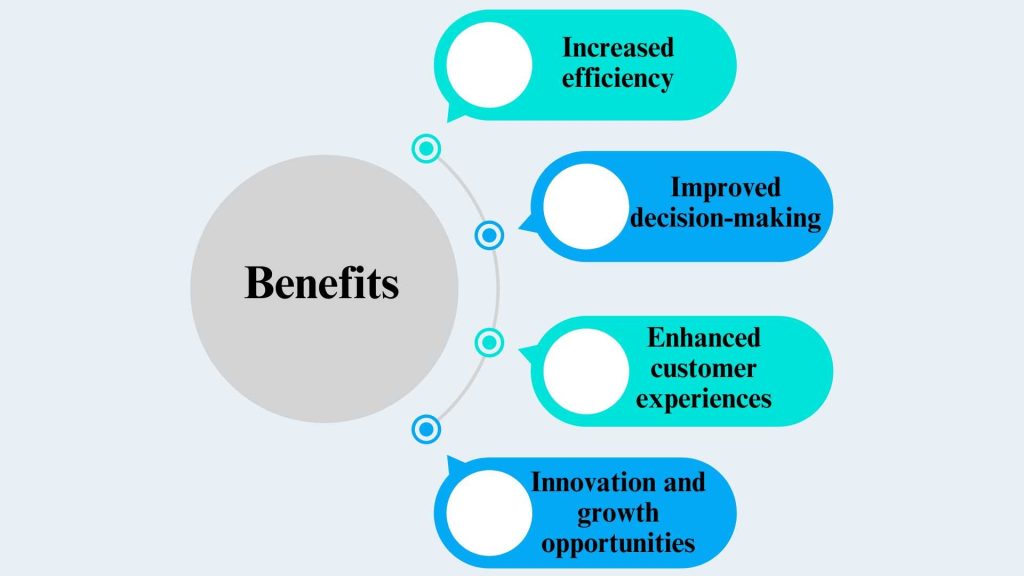
Strategies for Maximizing AI’s Potential
- Education and Training: In order to fully harness the potential of artificial intelligence (AI), education and training programs must be tailored to equip individuals with the necessary skills and knowledge. This involves initiatives at various levels:
- Academic Curriculum Enhancement: Educational institutions should integrate AI-related courses and modules into their curricula across disciplines.
- This includes computer science, engineering, mathematics, business, and even humanities.
- By doing so, students can gain foundational understanding and practical experience in AI concepts, algorithms, and applications.
- Vocational Training Programs: Beyond traditional academic routes, vocational training programs can provide specialized training in AI technologies and tools.
- These programs cater to professionals seeking to upskill or transition into AI-related roles.
- They offer practical, hands-on training to develop specific competencies relevant to industries adopting AI solutions.
- Lifelong Learning Initiatives: Given the rapid evolution of AI technologies, continuous learning is essential.
- Governments and organizations should invest in lifelong learning initiatives, such as online courses, workshops, and certifications, to enable individuals to stay updated with the latest advancements in AI.
- These initiatives should be accessible and affordable to ensure widespread participation.
- Interdisciplinary Collaboration: AI is a multidisciplinary field that intersects with various domains.
- Encouraging collaboration between different academic disciplines fosters a holistic understanding of AI’s potential applications and implications.
- For instance, collaborations between computer scientists, ethicists, policymakers, and social scientists can lead to more comprehensive approaches to AI education.
- Academic Curriculum Enhancement: Educational institutions should integrate AI-related courses and modules into their curricula across disciplines.
- Collaboration between Industry and Government: Realizing AI’s full potential requires close collaboration between industry stakeholders and governmental bodies. This partnership facilitates:
- Research and Development Funding: Governments can allocate funding for AI research and development initiatives, both in academia and industry.
- This financial support encourages innovation and accelerates the development of cutting-edge AI technologies.
- Industry players can also contribute by investing in research projects aligned with their strategic objectives.
- Regulatory Frameworks: Governmental agencies play a crucial role in establishing regulatory frameworks that govern the ethical use of AI technologies.
- These regulations address concerns related to data privacy, algorithmic transparency, bias mitigation, and accountability.
- Collaborative efforts between industry experts and policymakers ensure that regulations are informed by technical expertise and industry best practices.
- Industry Standards and Best Practices: Industry-led consortia and standards organizations can develop guidelines and best practices for AI development and deployment.
- These standards promote interoperability, security, and reliability across AI systems, fostering trust and facilitating market adoption.
- Government support may involve endorsing these standards or providing incentives for compliance.
- Talent Development Initiatives: Collaborative efforts between industry and government can address the growing demand for AI talent.
- This includes initiatives such as apprenticeship programs, scholarships, and sponsored research projects.
- By working together, stakeholders can ensure that the workforce is adequately skilled to drive AI innovation and adoption.
- Research and Development Funding: Governments can allocate funding for AI research and development initiatives, both in academia and industry.
- Ethical Guidelines and Regulations: As AI technologies become increasingly pervasive, it is imperative to establish ethical guidelines and regulations to govern their development and use. Key considerations include:
- Ethical AI Principles: Ethical guidelines articulate principles that guide the design, development, and deployment of AI systems.
- These principles encompass values such as fairness, transparency, accountability, and inclusivity.
- Stakeholders from diverse backgrounds, including ethicists, technologists, policymakers, and civil society representatives, collaborate to formulate these principles.
- Regulatory Oversight: Governments enact laws and regulations to ensure compliance with ethical standards and protect individuals from potential harm arising from AI applications.
- Regulatory oversight may involve mandates for algorithmic transparency, data protection measures, and impact assessments to identify and mitigate risks associated with AI deployment.
- International Cooperation: Given the global nature of AI development and deployment, international cooperation is essential in establishing harmonized ethical guidelines and regulatory frameworks.
- Multilateral agreements and forums facilitate knowledge sharing, best practices exchange, and coordination on cross-border AI issues.
- This cooperation promotes consistency and coherence in addressing ethical challenges associated with AI technologies.
- Continuous Evaluation and Adaptation: Ethical guidelines and regulations should be dynamic and adaptable to evolving technological landscapes and societal needs.
- Continuous evaluation mechanisms, such as periodic reviews and stakeholder consultations, ensure that regulatory frameworks remain relevant and effective over time.
- This iterative approach allows for timely adjustments to address emerging ethical concerns and technological advancements.
- Ethical AI Principles: Ethical guidelines articulate principles that guide the design, development, and deployment of AI systems.
By prioritizing education and training, fostering collaboration between industry and government, and implementing ethical guidelines and regulations, stakeholders can collectively maximize the potential benefits of AI while mitigating associated risks. These strategies promote responsible AI innovation and contribute to the advancement of society as a whole.
Artificial Intelligence: Successful Recognition Case Studies
Retail:
- Customer Insights and Personalization: AI algorithms analyze vast amounts of customer data to provide insights into consumer behavior, preferences, and trends.
- Retailers can then tailor their marketing strategies, product offerings, and pricing to specific customer segments, leading to increased sales and customer satisfaction.
- Inventory Management and Supply Chain Optimization: AI-powered systems optimize inventory levels by predicting demand, identifying trends, and automating reordering processes.
- This reduces stockouts, minimizes excess inventory, and improves overall supply chain efficiency, ultimately lowering costs and maximizing profits.
- Enhanced Customer Experience: AI chatbots and virtual assistants enable retailers to offer personalized customer support around the clock.
- These AI-driven solutions can handle customer inquiries, provide product recommendations, and even assist with purchases, enhancing the overall shopping experience and driving customer engagement.
Agriculture:
- Precision Farming: AI technologies such as drones, sensors, and satellite imagery are revolutionizing agriculture by providing farmers with real-time data on soil health, crop conditions, and weather patterns.
- This enables precision farming techniques, allowing farmers to optimize irrigation, fertilization, and pesticide usage, leading to higher yields and reduced environmental impact.
- Crop Monitoring and Disease Detection: AI algorithms can analyze images captured by drones or sensors to monitor crop health and detect early signs of diseases or pests.
- By identifying issues before they spread, farmers can take timely action to protect their crops, minimize losses, and ensure sustainable agriculture practices.
- Predictive Analytics for Yield Optimization: AI models leverage historical data, weather forecasts, and other relevant factors to predict crop yields with high accuracy.
- This information helps farmers make informed decisions regarding planting schedules, crop selection, and resource allocation, maximizing productivity and profitability.
Energy:
- Smart Grid Management: AI-powered algorithms optimize the operation of energy grids by forecasting demand, balancing supply and demand in real time, and routing electricity efficiently.
- This results in improved reliability, reduced energy wastage, and lower operational costs for utility companies and consumers alike.
- Predictive Maintenance for Infrastructure: AI analytics can analyze sensor data from energy infrastructure such as power plants, transmission lines, and wind turbines to detect anomalies and predict equipment failures before they occur.
- This proactive approach to maintenance minimizes downtime, extends asset lifespan, and ensures an uninterrupted energy supply.
- Energy Efficiency and Optimization: AI algorithms analyze energy consumption patterns in buildings, factories, and other facilities to identify opportunities for optimization and energy savings.
- By implementing smart controls, predictive maintenance, and energy management systems, businesses can reduce their carbon footprint, lower energy bills, and contribute to a more sustainable future.
These case studies illustrate how AI is transforming various industries by enabling data-driven decision-making, automation, and innovation. As AI continues to evolve, its potential to drive growth, efficiency, and sustainability across sectors will only continue to expand.
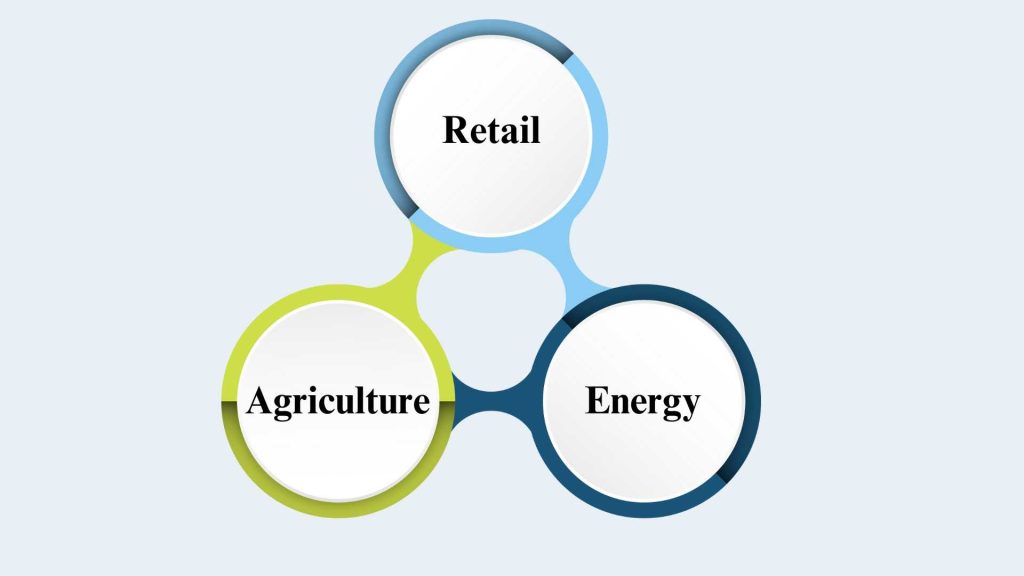
Conclusion
In conclusion, the potential of AI is vast and ever-expanding. Its applications span across various industries, from healthcare to finance, from transportation to entertainment. As AI technology continues to evolve, it promises to revolutionize how we live and work, offering solutions to complex problems and augmenting human capabilities. However, it also brings challenges such as ethical considerations, job displacement, and privacy concerns that need to be addressed. Overall, AI holds the promise of transforming society in profound ways, but its development must be guided by responsible practices to ensure its benefits are maximized while mitigating potential risks.
FAQ’s:
1. What potential does AI have?
AI has the potential to revolutionize nearly every aspect of our lives. From enhancing productivity in industries like manufacturing and agriculture to revolutionizing healthcare through personalized medicine and early disease detection, AI can streamline processes, improve decision-making, and solve complex problems at a scale previously unimaginable.
2. What is the true potential of AI?
The true potential of AI lies in its ability to mimic human intelligence and perform tasks that traditionally require human cognition, such as problem-solving, pattern recognition, and natural language understanding. With advancements in machine learning, deep learning, and neural networks, AI can continuously learn from data, adapt to new situations, and make predictions with increasing accuracy.
3. What will AI look like in 10 years?
In 10 years, AI is likely to be more integrated into our daily lives than ever before. We can expect to see advancements in areas such as autonomous vehicles, virtual assistants, medical diagnostics, and smart cities. AI systems will become more sophisticated, and capable of understanding and responding to human emotions, preferences, and intentions, leading to more personalized and intuitive interactions.
4. How powerful will AI be in 2030?
By 2030, AI is projected to be significantly more powerful and pervasive across industries and society. We can anticipate breakthroughs in Artificial Intelligence research leading to innovations in robotics, natural language processing, and computer vision. AI-powered technologies will become increasingly autonomous, able to make complex decisions in real time and contribute to solving some of the world’s most pressing challenges.
5. How advanced will AI be in 2050?
In 2050, AI is expected to have transformed society in ways that are difficult to fully comprehend today. With continued advancements in AI research and development, we may see AI systems that surpass human intelligence in certain domains, leading to unprecedented opportunities and challenges. From personalized education and healthcare to sustainable energy and climate modeling, Artificial Intelligence could play a central role in shaping the future of humanity. However, it’s crucial to ensure that AI is developed and deployed responsibly to maximize its benefits while minimizing risks.






